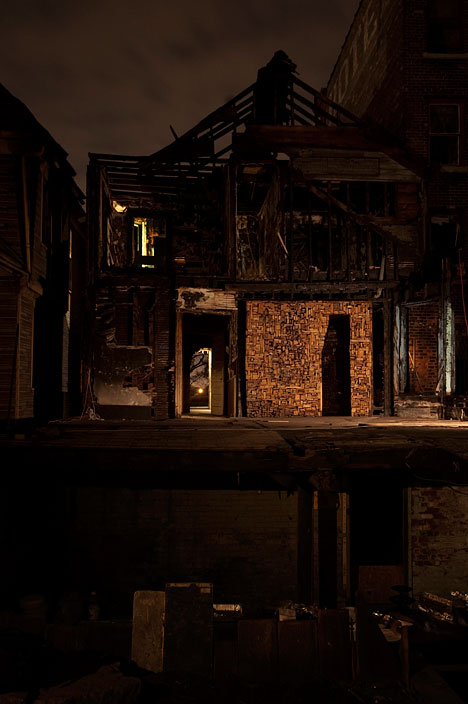 |
| Salvaged Landscape, inside |
 |
| Salvaged Landscape passageway |
“By its nature, the Internet undermined anyone whose status depended on a privileged access to information.”
—Michael M. Lewis, Next: The Future Just Happened
The loveland project has introduced inchvestments of so called microhoods, real urban lots in Detroit, that are made online, so you can say that they are rebuilding Detroit through the internet. (They are even suggesting that you buy inches as gifts) hardcore!
These spaces are located within housing and urban lots that are no longer 'productive', I am guessing that previous commercial and industrial ventures are now long gone as these buildings and lots ceased to be profitable and this obviously would've led to an abandonement in residential lots too. So these 'empty' urban lots have been standing in limbo waiting for somebody to come in and start making use of them. These microhoods are envisioned to be visitable park and garden spaces along with renovated abandonded buildings. Inchvestors buy into a set of inches and then collaborate with other inchowners in their microhood to carve out some fine ideas of what to develop on the sites. In other words, it sounds like the loveland project are creating a new type of public space based on the redundant urban spectacle. This is made possible by an innovative social tool, the internet. Watch the TED talk by founders Jerry Paffendorf and Mary Carter:
“Old ideas can sometimes use new buildings. New ideas must use old buildings."
Jane Jacobs, The Death and Life of Great American Cities
Loveland is a fantastic innovation in urban development and should receive praise on the highest level. Hopefully they can maintain this concept around community based ownership and investment. The danger in rejuvenation through the arts and crafts, through creative endevours is that a gentrification eventuates in those neighbourhoods as the creative lifestyles become fashionable and so you see residential prices shoot through the roof and eventually move the artists elsewhere.
 |
| Plymouth, Lovelands first digital/analogue neighbourhood. |
The Loveland website as it is formatted looks very digital. I mean, that IS the whole point. But, I guess what I am trying to convey is a need to perhaps start spatialising the incentives and the projects that are forming in the microhoods so that we can understand them more beyond a planning llot that is either square or rectangular and coloured in red, green or yellow. More pictures, more plans, sections etc. would aid in understanding the impact that this DIGITAL system as had on our ANALOGUE reality.
 |
| for more images, go to core77 |
Living in the map is a take on the rather drained and seemingly old expression of community consultation. The idea of traditional paper pushing and prolonged waiting periods due to bureaucratic red tape seem to have been moved aside as the internet provides a platform in redeveloping and rethinking Detroit. Imagination station is behind the Living in the map concept which is a continuation of the loveland project that basically offers people to invest in so called microhoods starting as small as an inch. Living in the map seems to have just been powered up and is a website still in need of some work but the general concept is to act as a social platform for job opportunities and for sharing general information and city data of what is going on in Detroit. Imagination station also thinks up clever reclamation installations and public artworks such as this beautiful piece by Katie Newell called Salvaged Landscape whereby she intervened in a burnt down building and used wood to reconfigure the destructed material and building into a so called passageway.
 | |
| more on the Salvaged Landscape project here |
Sewell is gradually demolishing this building turning it into an intervention in the process. Catie Newell describes it:
Salvaged Landscape appropriates the charred wood from an arsoned house to create spatial adjustments which uncover the material qualities reliant on flame to exist. Amidst a purposeful tear-down, the project responds to the new textures, spaces, and light effects that resulted both from the fire and demolition. Using existing material from the house as the palette and existing spaces as form-work, Salvaged Landscape creates a new room in the life of the house keying into the opportunities present in its own timeline; constructed with the demolition of the house occurring around it
Following insertion of the left-over firewood into the hollows of the savaged structure, the artist will attempt to invert the passageway. She wants to remove the remains of the old building structure and flip the passageway onto its side so that it becomes an impenetrable structure and a celebration of the building that once was...
No comments:
Post a Comment